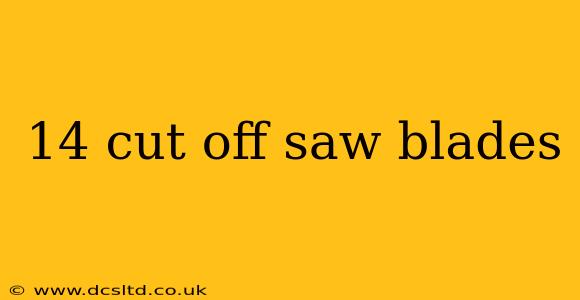Choosing the right cut-off saw blade is crucial for achieving clean cuts, maximizing blade life, and ensuring operator safety. This guide focuses specifically on 14" cut-off saw blades, exploring various types, applications, and factors to consider when selecting the best blade for your needs.
What are 14" Cut-Off Saw Blades Used For?
14-inch cut-off saw blades are commonly used in a variety of applications, primarily for cutting metal. The large diameter allows for efficient cutting of thicker materials and provides a more stable cutting process. These blades are frequently found in chop saws, abrasive cut-off saws, and miter saws used in metalworking, fabrication, and construction industries. They are capable of cutting various materials, including:
- Steel: Mild steel, stainless steel, alloy steel, and other ferrous metals.
- Aluminum: Various aluminum alloys.
- Other Metals: Brass, copper, and other non-ferrous metals.
The specific application will dictate the type of blade required, as discussed below.
What Types of 14" Cut-Off Saw Blades are Available?
Several types of 14" cut-off saw blades cater to different materials and cutting requirements:
-
Abrasive Blades: These blades utilize abrasive segments bonded to a steel core. They are highly effective for cutting a wide range of metals, including those that are hard or difficult to machine. Abrasive blades are known for their aggressive cutting action and ability to handle thicker materials. However, they tend to generate more heat and wear out faster than other types.
-
Diamond Blades: Designed for cutting extremely hard materials like concrete, stone, and tile, diamond blades are less common in the 14" cut-off saw context for metal cutting. While they can cut metal, they are generally less efficient than abrasive blades for this purpose and are considerably more expensive.
-
Friction Blades: (Less common in 14" size): These blades rely on friction to cut the material. They are typically used for softer materials and are known for producing cleaner cuts with less material deformation. In a 14" size for metal cutting, these are less prevalent.
What are the Key Factors to Consider When Choosing a 14" Cut-Off Saw Blade?
Selecting the appropriate 14" cut-off saw blade hinges on several critical factors:
-
Material to be cut: The type of metal (steel, aluminum, etc.) will determine the appropriate blade type and abrasive composition.
-
Thickness of the material: Thicker materials require blades with a higher tooth count or more aggressive abrasive segments.
-
Desired cut quality: Some applications demand very clean, smooth cuts, while others prioritize speed and efficiency.
-
Saw type: The type of cut-off saw (chop saw, abrasive cut-off saw, etc.) will influence the blade type and mounting specifications.
-
Blade speed: The blade's recommended operating speed must match the saw's capabilities to avoid damage to the blade or saw.
How Do I Choose the Right Abrasive for My 14" Cut-Off Saw Blade?
The abrasive used on a cut-off saw blade is critical to its performance. Different abrasives are formulated for specific materials and cutting characteristics:
-
Aluminum Oxide: Commonly used for cutting various metals, offering a good balance of cutting speed and blade life.
-
Silicon Carbide: Suitable for cutting hard and abrasive materials, providing a longer lifespan but potentially slower cutting speed.
-
CBN (Cubic Boron Nitride): An extremely hard abrasive, best suited for cutting very hard materials, offering exceptional durability but higher cost.
The abrasive type will be specified by the manufacturer and should be carefully considered based on the material being cut.
How Often Should I Replace My 14" Cut-Off Saw Blade?
Blade life depends on factors like material being cut, cutting frequency, and proper usage. Signs of needing replacement include:
- Excessive wear: Noticeably worn teeth or segments.
- Reduced cutting efficiency: Slower cutting speeds or increased effort required.
- Blade damage: Cracks, chips, or other visible damage.
Regular inspection and prompt replacement of worn blades are crucial for safety and efficiency.
What Safety Precautions Should I Take When Using a 14" Cut-Off Saw Blade?
Safety should always be the top priority when using any power tool. Always:
- Wear appropriate safety gear: Eye protection, hearing protection, and gloves are essential.
- Use proper clamping techniques: Secure the workpiece firmly to prevent movement during cutting.
- Follow manufacturer's instructions: Adhere to all safety guidelines provided by the saw and blade manufacturer.
- Inspect the blade before each use: Check for any signs of damage or wear.
- Never operate the saw if you are fatigued or impaired: Maintain focus and alertness at all times.
By following these guidelines, you can ensure a safer and more productive experience when working with 14" cut-off saw blades. Remember to consult the manufacturer's specifications and safety instructions for your specific saw and blade.
